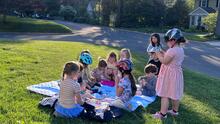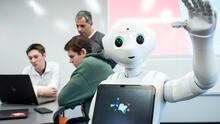Swapping Screens for Sidewalks: HawkMates Featured in ‘Time’ Magazine Urge Parents to Prioritize Real-Life Connections
And then in schools, we’ve accelerated discussions around balancing technology and focused on “transition years.” Every school might be different, but in our community, the cultural norm has been to get a smartphone as you enter middle school. We held an educational event with a clinical psychologist this year to talk to parents and students about the fifth grade brain and how important it is to create confidence pathways and independence pathways instead of scrolling pathways — and they got it. Only three fifth graders have smartphones this year [compared to 55 the year prior].
How has your Jesuit education impacted your work with the nonprofit?
Holly: Every day, we’re embracing the idea of men and women with and for others, and we’re thinking of our kids as whole people, mind, body and spirit. It’s woven into the fabric of who we are, how we parent and how we have approached our work.
How are you growing the Balance Project beyond Little Silver, New Jersey?
Holly: We have 100 communities across the country and one starting up in India. We’re growing it mostly by word of mouth, and then we’ve been working with a wonderful dad and developer in Chicago, who helped us build an online platform, Four Norms, to scale it very quickly. It's very exciting and we hope to continue to grow and spread our message to even more communities!
Full-time jobs, three kids, a nonprofit — how do you balance it all?
Ryan: We’re not! We work during the day, take care of our kids when we get home and work on The Balance Project when they go to bed. We’re repurposing what used to be date night for Board of Education meetings — but then we go out to dinner afterward.
Holly: We find it fun. And this is meaningful, purposeful work that is going to impact our kids and other kids.
In your recent Time magazine feature — congratulations, by the way — you spoke of balancing technology and real life. What does that look like in your home?
Holly: We made our kids a part of the conversation. We approached them and said, we’re learning more about how watching TV and spending too much time on screens isn’t good for your brain so we’re going to limit the amount of time we spend on screens. And they get it. They know we’re not making rules for rules’ sake. And they hold us accountable, too!
That's great! Is it hard to practice what you preach?
Ryan: In the beginning, I was not good about my own personal screen time. I was compulsively checking my phone and feeling the need to respond to things right away. But when you start to set healthy habits and boundaries, you start to feel the impact.
Now we’re trying to model behaviors with our screen time; the activities we do; the responsibility, independence and unstructured time we give our kids — in the hopes that others will be inspired to join us, too.
Interested in learning more or getting involved? Visit the Balance Project website for more details or read their Time magazine feature.
Latest News
- Hawks Participate in Pilgrimage of Hope for CreationOct.
- Hacking for a Safer WorldThis protection is especially important to the team as they continue their long-term partnership
- Saint Joseph’s Ranked Among Top 10 by ‘U.S. News & World Report’Saint Joseph’s University has once again been recognized as a leader in higher education, ranking No. 6 in U.S. News & World Report’s Regional Universities North category for 2026.
- Prevention Academy Expands into Montgomery County with New GrantSaint Joseph’s University’s Prevention Academy is expanding into Montgomery County, thanks to a new $1.9 million grant from the county’s










